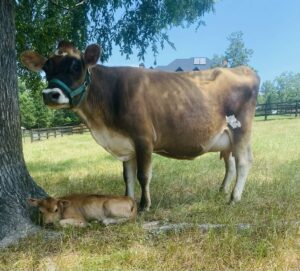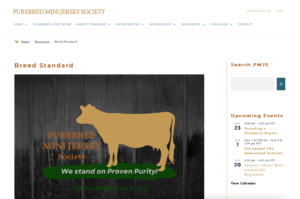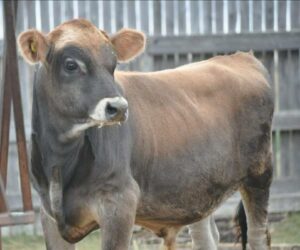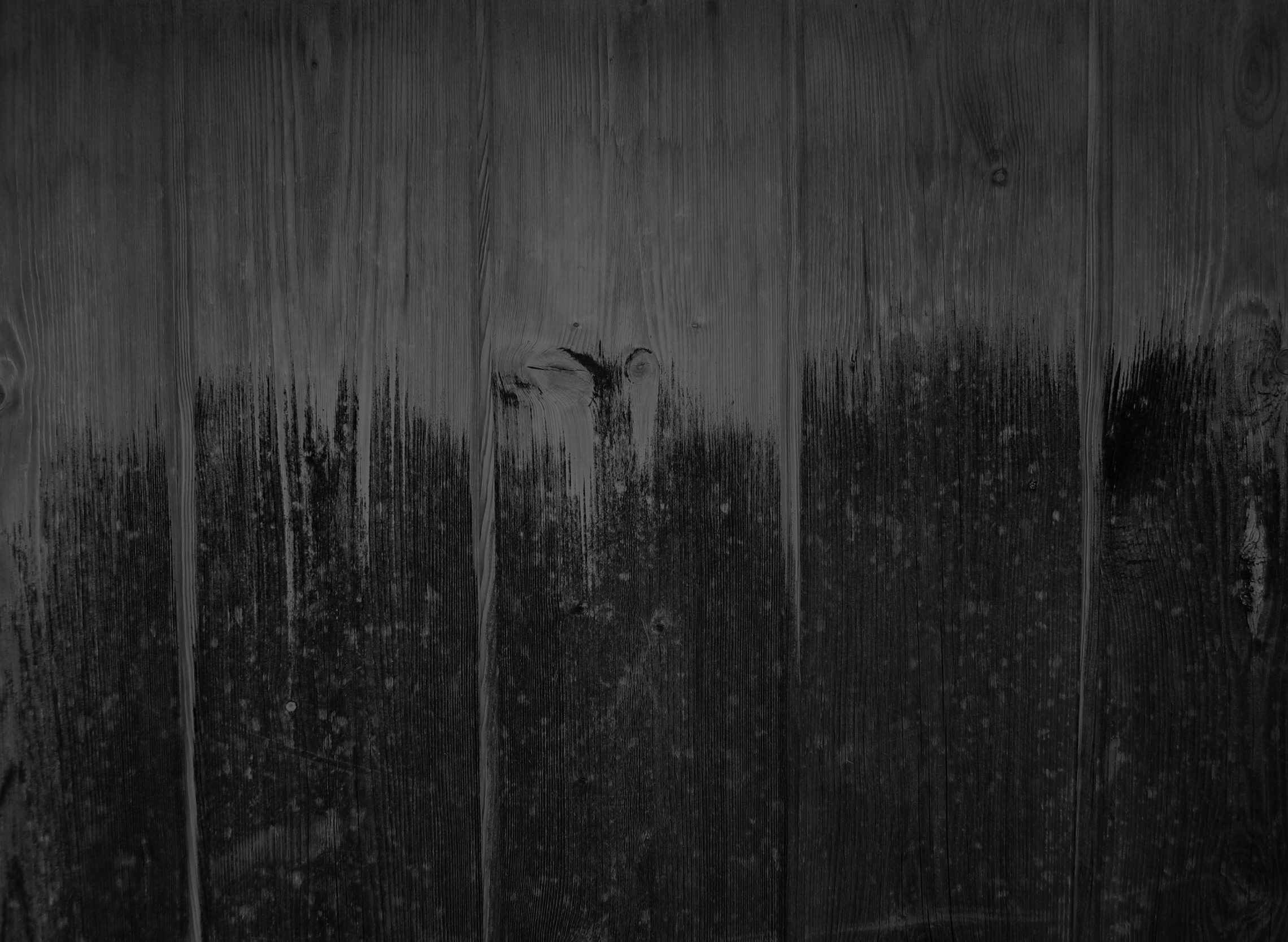
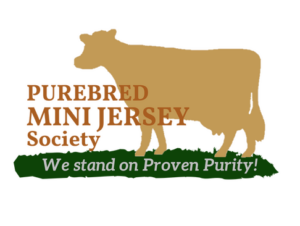
Buying or Selling Stock
Conformation
Conformation is the structure or outline of an animal, determined by the symmetrical arrangement of its parts. The way they are constructed from the set of the tail and ears to
how their feet meet the ground, and everything in between, is the conformation, literally meaning how they conform to the Breed Standard. It’s about the shape of different parts of their body and how the bones are aligned to meet each other.
Have you ever seen a cow that looks like two halves stuck together? The front and back ends aren’t balanced. That’s an element of conformation that’s easy to identify, even if you weren’t aware of why it looked wrong. Conformation is about the structure of the legs, spring of the ribs, hip bone width, topline, and the relative proportions overall.
Purebred Mini Jersey conformation is about how cattle look, not necessarily about genomics, but they will pass on these physical traits to some degree. Conformation has far reaching effects on some things. A high pelvic tilt, for example, can affect calving ease, just as a very low udder can make teats harder for a calf to reach and nurse. Conformation can manifest in longevity and health. That very low udder, for example, can make her prone to mastitis. A weak rear end or extremely sickle legs can mean injury when mounted during standing heat.
You can learn to judge Mini Jersey conformation. Look carefully at the pictures on this website then look at those in Google or Facebook.
The more pictures you look at the better to train your eye. What do you notice now after utilizing the links below?
Education:
Anatomy:
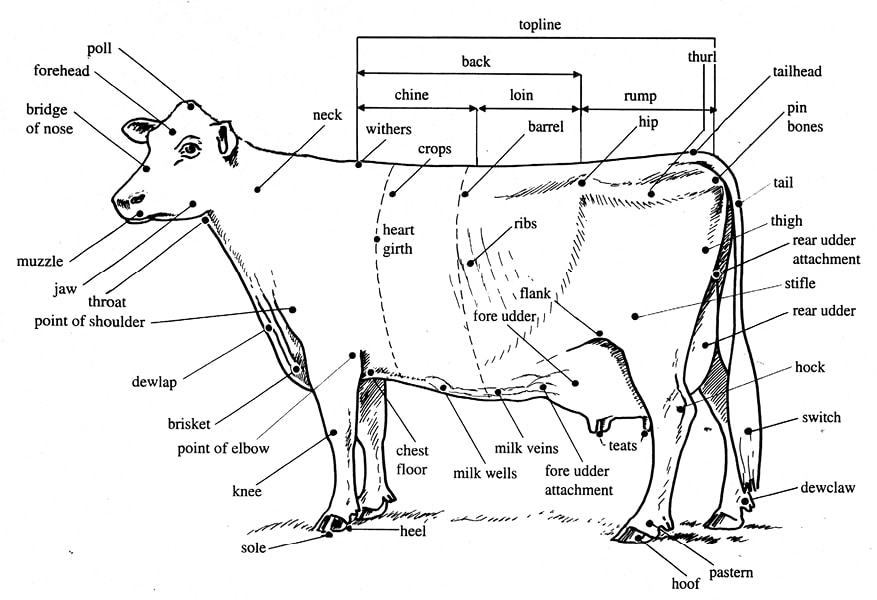
Information
Basic Stats:
- Full Registered Name
- Location
- Price
- Birth Date
- Height & age it was taken
- BBR
- Polled or horned
- A2, Kappa Casein, & Beta Lactoglobulin milk proteins
- Pedigree/bloodlines
- Registration numbers
- UC Davis file number
- Genomics/Performance Report
- Health screening tests
- Vaccinations
- Previous herds & transportation history
Photos:
- Get clear pictures, featuring the best aspects, showing full sides, left and right, taken squarely on at the height of the animal.
- Stance should show the full legs, front and back, and show the feet clearly as they meet the ground.
- Head profile and face, including ears.
- Rear and escutcheon, move the tail aside and show the space below the rectum and include the scrotum or udder.
- Scrotum or udder from rear and side.
- For a heifer or bull, it’s important to have pictures of the dam’s full udder and sire’s scrotum. These give a glimpse of what genetics they carry and will pass on.
- For cows, you need to see the udder, full before milking, if possible. Try to include all 4 teats so the placement and angle can be seen. Include a rear picture, moving aside the tail, so the escutcheon, depth and width are shown.
Proof of Height:
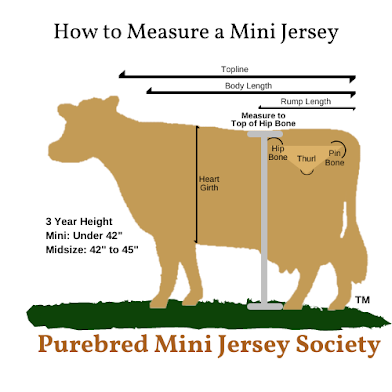
You’ll want to have a few pictures with a cattle panel, bucket, gate, person, or t-post to show height. Better still, take a video without edits or breaks showing a tape measure and level at the top of the hip down to the ground and hoof.
Health Screening:
– The seller CAN do health screening tests before selling or ask the buyer to pay for the tests they want. Suggested tests include BLV, BVD, Johne’s, Q-Fever, TB, and Brucellosis for cows. Bulls should additionally be tested for Trichinosis. Your veterinarian may advise additional tests based on the history of the animal and the location. Climate plays a factor in prevalence of some diseases. Its advised that a third party perform the testing. If you’re buying and can’t be present, call the vet that drew the blood and ask them to describe the cow to confirm it’s the correct animal.
– Zoonotic Diseases are transmittable from animals and people. When consuming raw dairy products its important that the cow is healthy so you remain healthy.
– Travel history is a factor in exposure to diseases. Was the cow born in a different state or on a different farm? How was she transported? Sometimes cows are transported in a trailer with other cattle. Diseases can easily be spread in a situation with nose to nose contact, where water is shared, and bedding is contaminated by feces. Additionally, has the cow been off the property for vet care, commercial dairy use, or livestock shows? Did she travel to the Fair?
– Has a cow been used to raise graft calves? Where were the calves obtained? Many commercial dairies sell their surplus heifers and unwanted bull calves as graft calves. This is a great way for people to manage extra milk or raise beef for the freezer. Sadly, many commercial facilities are positive for diseases in their herds.
– Have any cattle been brought into the herd? Have cattle from auction houses been added to the herd? Does the cow range with a beef herd when dry? Has a bull been used as a stud or have cows visited his pasture for breeding? Has a bull been used as a “clean up bull”?
While these are all common practices among dairymen and homesteads, they do expose some risks. Its best to ask and make an informed decision.
For Cows:
For example, the pictures below are all of the same cow. Its best to have more pictures than not enough.
Your cow may not be perfect but none of them are! Do your best to show her topline, legs, udder attachments/suspensory ligaments, thigh, heart girth, etc. The cow above has a narrow udder width and the rear teats are placed closer together than is ideal. You can clearly see the teat length and angles. She made a wonderful family cow for a small family who doesn’t mind.
For Bulls:
For a bull or bull calf you’ll want to confirm both testes are present. The angle, neck length, and placement of teats on the scrotum correlate to the udders he will put on his daughters. A longer neck will be a lower hanging udder with weaker suspensory ligaments, for example. The scrotum, hair texture and color on a bull tell us about his fertility and genetic traits. There’s a lot more than conformation to be seen in a photo! To learn more you can read these articles:
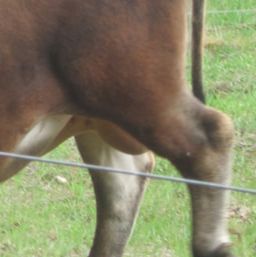
This mature bull has an ideal scrotum tilt and the neck has pulled the testes up near the body during the cold weather.
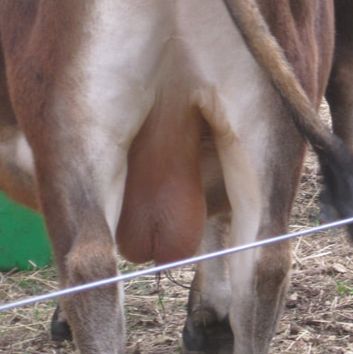
The same mature bull on a hot day, testes away from the body showing the neck and strong support. His daughters will have high, tight udders.
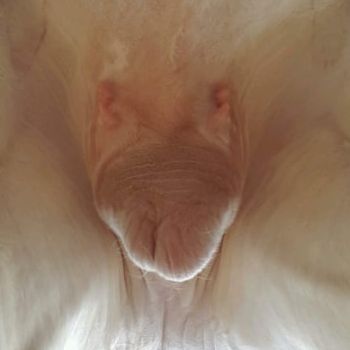
This bull calf’s scrotum has no neck, imbalance suggests low fertility. Long teats are well placed but at odd angles. He’s not an ideal herd sire.
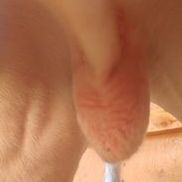
This bull calf’s scrotum has the ideal football shape. Teats are high, well spaced, but small. His fertility and daughter’s udders will be much better.
A Word on Inbreeding and Line-Breeding:
Simply said, avoid inbreeding. Some will tell you it locks in good traits, but it also lock in bad ones. Often, you won’t know until the next generation or later. Unfortunately, history tells us there’s a loss of fertility that comes with “close breeding”. Low fertility isn’t a trait we want to increase in our herds. Given the value of the Purebred Mini Jersey, its best not to participate in the practice. If you’d like to read up more on the subject there’s a very comprehensive article.
PMJS Policy
It’s recommended the coefficient is 12.5% and under. No animal with a Genomic Inbreeding Percentage over 25% will be registered*, meaning, no mother/son, father/daughter, half or full sibling breeding. Allowed but not recommended are full first cousins and grandparent/grandchild.
Of course, you may choose to tightly line-breed but those animals resulting cannot be presented for Registration or Certification as Breeding Stock, will be considered inbred, and will not be admitted into the Purebred Mini Jersey Society Herd Book. However, the next generation offspring may be permitted if all requirements are met. If there are questions or concerns, contact us. The Advisory Board will be happy to review the application.
*AI bulls with inbreeding collected prior to the inception of PMJS (Aug 2019) are grandfathered in for use of the genetics with a cow or heifer that is 100% unrelated, as in with a standard Jersey bloodline or known Mini Jersey pedigree.
To do further research on this topic we suggest you read this article.
Get this FREE tracking system with a calculator that can help determine Inbreeding Coefficient:
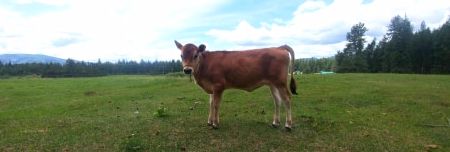
To visit the PMJS Cattle Market click here:
To join the PMJS Waiting List click here:





